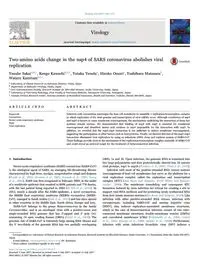
2017 Two-amino acids change in the nsp4 of SARS coronavirus abolishes viral replication PDF
Preview 2017 Two-amino acids change in the nsp4 of SARS coronavirus abolishes viral replication
Contents lists available at ScienceDirect Virology journal homepage: www.elsevier.com/locate/yviro Two-amino acids change in the nsp4 of SARS coronavirus abolishes viral replication Yusuke Sakaia,d,1, Kengo Kawachia,b,1, Yutaka Teradaa, Hiroko Omoric, Yoshiharu Matsuurab, Wataru Kamitania,e,⁎ a Laboratory of Clinical Research on Infectious Diseases, Osaka, Japan b Department of Molecular Virology, Osaka, Japan c Core Instrumentation Facility, Research Institute for Microbial Diseases, Osaka University, Osaka, Japan d Laboratory of Veterinary Pathology, Joint Faculty of Veterinary Medicine, Yamaguchi University, Yamaguchi, Japan e Tsukuba Primate Research Center, National Institutes of Biomedical Innovation, Health and Nutrition, Tsukuba, Ibaraki 305-0843, Japan A R T I C L E I N F O Keywords: Coronavirus Severe acute respiratory syndrome Nsp4 Viral replication A B S T R A C T Infection with coronavirus rearranges the host cell membrane to assemble a replication/transcription complex in which replication of the viral genome and transcription of viral mRNA occur. Although coexistence of nsp3 and nsp4 is known to cause membrane rearrangement, the mechanisms underlying the interaction of these two proteins remain unclear. We demonstrated that binding of nsp4 with nsp3 is essential for membrane rearrangement and identified amino acid residues in nsp4 responsible for the interaction with nsp3. In addition, we revealed that the nsp3-nsp4 interaction is not sufficient to induce membrane rearrangement, suggesting the participation of other factors such as host proteins. Finally, we showed that loss of the nsp3-nsp4 interaction eliminated viral replication by using an infectious cDNA clone and replicon system of SARS-CoV. These findings provide clues to the mechanism of the replication/transcription complex assembly of SARS-CoV and could reveal an antiviral target for the treatment of betacoronavirus infection. 1. Introduction Severe acute respiratory syndrome (SARS) coronavirus (SARS-CoV) is the etiological agent of SARS, an emerging life-threatening disease characterized by high fever, myalgia, nonproductive cough and dyspnea (Booth et al., 2003; Drosten et al., 2003; Ksiazek et al., 2003; Tsang et al., 2003). SARS was first recognized in February 2003, in the midst of a worldwide epidemic that resulted in 8096 patients and 776 deaths, with the last patient being reported in 2004 (de Wit et al., 2016). In 2012, nearly a decade after the SARS epidemic, a novel coronavirus, the Middle East respiratory syndrome (MERS) coronavirus (MERS- CoV), emerged in Saudi Arabia (Zaki et al., 2012) and has since spread to other countries in the Middle East, North Africa, Europe and Asia. SARS-CoV belongs to the genus Betacoronavirus in the family Coronaviridae, and is an enveloped virus with a positive-sense and single-stranded RNA genome that has 5’capped and 3’ poly (A)- containing 14 open reading frames (ORFs) (Thiel et al., 2003). The genomic size of SARS-CoV is extremely large among RNA viruses and the 5’ two-thirds of the genomic RNA has two partially overlapping ORFs, 1a and 1b. Upon infection, the genomic RNA is translated into two large polyproteins and then proteolytically cleaved into 16 mature viral proteins, nsp1 to nsp16 (Prentice et al., 2004; Thiel et al., 2003). Infection with most of the positive-stranded RNA viruses induces rearrangement of host cell membranes that serve as the platform for a viral replication complex called the replication and transcription complex (RTC) (den Boon and Ahlquist, 2010; Miller and Krijnse- Locker, 2008). The membrane remodeling and consequent RTC formation induced by virus infection are critical for creating a site to support viral RNA synthesis and for protecting newly synthesized RNA from host innate immune systems (den Boon and Ahlquist, 2010). Like infection with other positive-stranded RNA viruses, infection with coronaviruses, including SARS-CoV and murine hepatitis virus (MHV), also induces replication-associated membrane structures, which in the case of betacoronavirus infection consist of two inter- connected membrane structures, double-membrane vesicles (DMVs) and convoluted membranes (CMs) (Goldsmith et al., 2004; Gosert et al., 2002; Knoops et al., 2008; Snijder et al., 2006). Furthermore, infection with avian infectious bronchitis virus (IBV) induces a http://dx.doi.org/10.1016/j.virol.2017.07.019 Received 5 June 2017; Received in revised form 9 July 2017; Accepted 14 July 2017 ⁎ Correspondence to: Laboratory of Clinical Research on Infectious Diseases, Research Institute for Microbial Diseases, Osaka University, 3-1 Yamadaoka, Suita-shi, Osaka 565-0871, Japan. 1 These authors contributed equally to this work. E-mail address:
